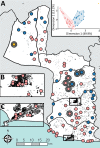Epidemiologic and Genomic Reidentification of Yaws, Liberia
- PMID: 33754988
- PMCID: PMC8007311
- DOI: 10.3201/eid2704.204442
Epidemiologic and Genomic Reidentification of Yaws, Liberia
Abstract
We confirmed endemicity and autochthonous transmission of yaws in Liberia after a population-based, community-led burden estimation (56,825 participants). Serologically confirmed yaws was rare and focal at population level (24 cases; 2.6 [95% CI 1.4-3.9] cases/10,000 population) with similar clinical epidemiology to other endemic countries in West Africa. Unsupervised classification of spatially referenced case finding data indicated that yaws was more likely to occur in hard-to-reach communities; healthcare-seeking was low among communities, and clinical awareness of yaws was low among healthcare workers. We recovered whole bacterial genomes from 12 cases and describe a monophyletic clade of Treponema pallidum subspecies pertenue, phylogenetically distinct from known TPE lineages, including those affecting neighboring nonhuman primate populations (Taï Forest, Côte d'Ivoire). Yaws is endemic in Liberia but exhibits low focal population prevalence with evidence of a historical genetic bottleneck and subsequent local expansion. Reporting gaps appear attributable to challenging epidemiology and low disease awareness.
Keywords: Liberia; Treponema pallidum; West Africa; accessibility; bacteria; bottleneck; case detection; case finding; genome; neglected tropical diseases; nonhuman primate; pertenue; sequencing; yaws.
Figures




Similar articles
-
Geographically structured genomic diversity of non-human primate-infecting Treponema pallidum subsp. pertenue.Microb Genom. 2020 Nov;6(11):mgen000463. doi: 10.1099/mgen.0.000463. Microb Genom. 2020. PMID: 33125317 Free PMC article.
-
Knowledge, attitudes and practices towards yaws in endemic areas of Ghana, Cameroon and Côte d'Ivoire.PLoS Negl Trop Dis. 2024 Jun 20;18(6):e0012224. doi: 10.1371/journal.pntd.0012224. eCollection 2024 Jun. PLoS Negl Trop Dis. 2024. PMID: 38900827 Free PMC article.
-
Integrated approach in the control and management of skin neglected tropical diseases in three health districts of Côte d'Ivoire.BMC Public Health. 2020 Apr 17;20(1):517. doi: 10.1186/s12889-020-08632-6. BMC Public Health. 2020. PMID: 32303204 Free PMC article.
-
Yaws.Int J STD AIDS. 2015 Sep;26(10):696-703. doi: 10.1177/0956462414549036. Epub 2014 Sep 4. Int J STD AIDS. 2015. PMID: 25193248 Free PMC article. Review.
-
Epidemiology of yaws: an update.Clin Epidemiol. 2014 Apr 2;6:119-28. doi: 10.2147/CLEP.S44553. eCollection 2014. Clin Epidemiol. 2014. PMID: 24729728 Free PMC article. Review.
Cited by
-
Is there still yaws in Nigeria? Active case search in endemic areas of southern Nigeria.PLoS Negl Trop Dis. 2023 Nov 20;17(11):e0011753. doi: 10.1371/journal.pntd.0011753. eCollection 2023 Nov. PLoS Negl Trop Dis. 2023. PMID: 37983269 Free PMC article.
-
A new typing scheme demonstrates high discriminatory power for Treponema pallidum subspecies.bioRxiv [Preprint]. 2025 Jul 10:2025.07.10.664125. doi: 10.1101/2025.07.10.664125. bioRxiv. 2025. PMID: 40672163 Free PMC article. Preprint.
-
How to find a forgotten disease like yaws: Lessons from the Philippine experience.PLoS Negl Trop Dis. 2023 Sep 14;17(9):e0011515. doi: 10.1371/journal.pntd.0011515. eCollection 2023 Sep. PLoS Negl Trop Dis. 2023. PMID: 37708120 Free PMC article. No abstract available.
-
The genomes of the yaws bacterium, Treponema pallidum subsp. pertenue, of nonhuman primate and human origin are not genomically distinct.PLoS Negl Trop Dis. 2023 Sep 13;17(9):e0011602. doi: 10.1371/journal.pntd.0011602. eCollection 2023 Sep. PLoS Negl Trop Dis. 2023. PMID: 37703251 Free PMC article.
-
Yaws in Africa: Past, Present and Future.Diseases. 2025 Jan 14;13(1):14. doi: 10.3390/diseases13010014. Diseases. 2025. PMID: 39851478 Free PMC article. Review.
References
-
- World Health Organization Department of Control of Neglected Tropical Diseases. Summary report of a consultation on the eradication of yaws. Geneva: The Organization; 2012.
-
- Fitzpatrick C, Asiedu K, Solomon AW, Mitja O, Marks M, Van der Stuyft P, et al. Prioritizing surveillance activities for certification of yaws eradication based on a review and model of historical case reporting. PLoS Negl Trop Dis. 2018;12:e0006953. 10.1371/journal.pntd.0006953 - DOI - PMC - PubMed
-
- World Health Organization (WHO). Results of the 2017 global WHO survey on yaws. Wkly Epidemiol Rec. 2018;93:417–28.
Publication types
MeSH terms
Grants and funding
LinkOut - more resources
Full Text Sources
Other Literature Sources

